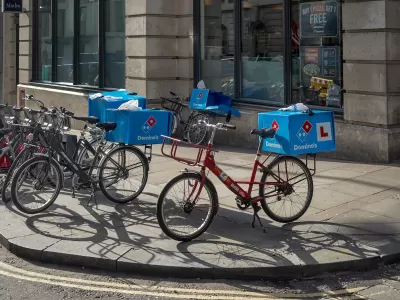Bike advocates attribute the growth to new protected bike lanes.

Cargo bikes are growing in popularity in London after the introduction of ‘Cycle Superhighways’ in 2015, reports Carlton Reid for Forbes.
The use of cargo bikes grew by 73 percent in London’s central square mile and by 63 percent across the city between 2022 and 2023 as more businesses shifted to delivery bikes to reduce carbon emissions and make deliveries cheaper and more efficient. A campaign called Clean Cargo Capital is calling on the city to do more to support the adoption of cargo bikes for deliveries. Unlike other European cities, London does not offer subsidies to businesses for switching to cargo bikes. “Clean Cargo Capital wants TfL to create a Bikes for Business project that can offer not just tailored cargo bike advice to businesses but also provide the sort of subsidies that are common in other European cities.”
According to Reid, “Transport for London (TfL) highlights that cargo bikes could replace nearly one in five vans in parts of London by 2030. Campaigners believe this target is too tame and are calling on Mayor Sadiq Khan to accelerate policies to favor cycling and cargo bike use.”
FULL STORY: Cargo Bike Use In City Of London Up By 73%, Analysis Shows

Trump Administration Could Effectively End Housing Voucher Program
Federal officials are eyeing major cuts to the Section 8 program that helps millions of low-income households pay rent.

Planetizen Federal Action Tracker
A weekly monitor of how Trump’s orders and actions are impacting planners and planning in America.

Ken Jennings Launches Transit Web Series
The Jeopardy champ wants you to ride public transit.

Sacramento Plans ‘Quick-Build’ Road Safety Projects
The city wants to accelerate small-scale safety improvements that use low-cost equipment to make an impact at dangerous intersections.

How Project Connect Would Change ‘The Drag’
A popular — and sometimes deadly — Austin road will exchange car lanes for light rail.

Milwaukee Road to Get Complete Streets Upgrades
The city will reduce vehicle lanes and build a protected multi-use trail including bioswales and other water retention features on its ‘secret highway.’
Urban Design for Planners 1: Software Tools
This six-course series explores essential urban design concepts using open source software and equips planners with the tools they need to participate fully in the urban design process.
Planning for Universal Design
Learn the tools for implementing Universal Design in planning regulations.
Ada County Highway District
Clanton & Associates, Inc.
Jessamine County Fiscal Court
Institute for Housing and Urban Development Studies (IHS)
City of Grandview
Harvard GSD Executive Education
Toledo-Lucas County Plan Commissions
Salt Lake City
NYU Wagner Graduate School of Public Service





























